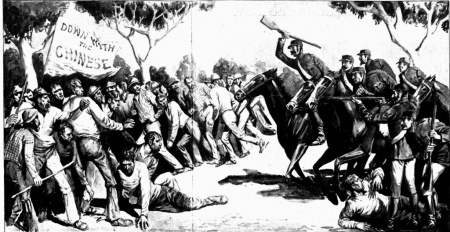Lambing Flat
Februrary 1851 saw the discovery of gold around Ophir, NSW: John Lister went on again to find 120 grams of gold in April of the same year; around the same time gold was found in Castlemaine, Sofala, Warrandyte, Clunes, Bungonia, Moruya, Ballaarat and Bendigo. The lower classes of the world were jolted from their servility and saw a chance to make their fortunes, Australia before this period was heavily underpopulated; it is estimated the few decades of the rush caused the population to triple from 430,000 in 1851 to 1.7 Million in 1871; among these some 11,493 Chinamen arrived in Melbourne in 1855; immediately provoking the Government to act for the Chinese Immigration Act of 1855 which significantly reduced the number of Chinese allowed to arrive on a single ship.
Unfortunately for Victorians the border of South Australia had no such restriction; and as a result the following years saw great movements of Chinese into Victoria and NSW through the South Australian border; the influx however did not only occur there: In 1877 newspapers lit up with the headlines “The Chinese Invasion” depicting the influx of some many thousands of Chinese through the loose borders of what is now the Northern Territory.
Australian workers felt this large influx of non-Europeans was like an “uncalculating impulsive rush of a herd of animals.” as one newspaper recalled, an ‘invasion’, a ‘menace’ not only for working men in the cities whom now had been muscled out of their factory jobs: but too for the men on the farms and the gold-fields: 1861 saw one of the first shots of explicit white rebellion against coloured migration, William Spence: The founder of the Australian Labor Party recalled “They drove the Chinese off the field, some of the pig-tailed heathens losing their lives.”
The rebellion started with a public meeting in which a petition was signed praying to the Government to decide whether Burrangong was to be ‘white or yellow territory’.
Reverend W. H. Pownall records “The anger of European elements grew as the Chinese warmed up to [mining], action was decided upon: about 3,000 men accompanied by a band playing “Rule Britannia” marched from Tipperary Gully to Victoria hill. The Chinese may have heard the band drawing near, they worked and jabbered and took no notice. The avalanche was upon them before they suspected.
The Chinese were seized and thrown down the holes. Their pigtails were cut off and sometimes scalps were retained as trophies: Tents and equipment were collected and a bonfire was made in the midst of the Flat. The mob then swept on to Back Creek for further acts of violence.
The small body of police was helpless, arrests were made during the week and the miners demanded release of the prisoners, but were refused.
The following Sunday another procession was formed, which marched to police headquarters. The leaders again demanded the prisoners, without result: A state of siege ensued, shots from both sides were fired at lengthy intervals.
Knowing they were greatly outnumbered, the police cleverly withdrew and were well on the way to Yass before the mob knew they had gone. A yell was raised and the barracks were stormed, the prisoners released and finally the station and contents were set on fire.”
